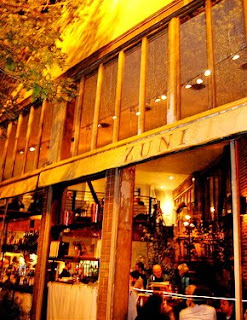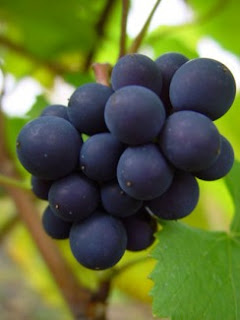Posts
- Get link
- X
- Other Apps
- Get link
- X
- Other Apps
- Get link
- X
- Other Apps
Back Burners
The state of Syrah, its ideal food matches, and a short list of inspiring American producers
Since the beginning of the year (2009) I’ve made no less than four extended passes through the West Coast, and one of the most significant things that I have found is this: the West Coast makes kick-butt syrah. I mean, not just a handful of significant syrahs, but an entire Sgt. Pepper’s bandwagon of them. Gloriously rich, complex, inspiring, soaring syrahs – everything a wine lover, any wine lover, would want. Yet, in how many places are you hearing people say, with palpitating enthusiasm, that American grown syrahs have reached exalted levels – which they most certainly have – in the same way chardonnays and cabernet sauvignons did in the wake of the Judgement of Paris way back when, before our kids were born, or pinot noirs in the days before and after “that movie?” It’s such a shame: that the dramatically ascendant quality of California, Washington and (especially) Oregon syrahs has been met with a collective yawn. Invariably, this brings up talk of sales. It’s being sai...
Chicken (recipes & wine matches) everybody loves
Let’s talk chicken and wine matches. But why? The way I see it: I learned long ago that ordering chicken in every restaurant gives you a pretty good idea of how good, bad, or detail oriented every restaurant's chef is. I know why, as a result, Blue Hill in New York, Zuni in San Francisco, and Le Pigeon in Portland are among my favorite restaurants in the country: they do chicken right. Chicken loves bottled company, and picking a good one is not one of life’s most difficult tasks. The great thing about chicken, of course, is that there are 1,001 ways to cook it; and undoubtedly a 1,001 different wines to go with it. Well, probably more than that. But for someone with as catholic a taste as mine, this is heaven, plain and simple. Chicken must be eaten with wine because that’s what elevates it no matter how it’s made. No one breathlessly writes home to say, "I found the perfect tea for har yee kai ” (“beggar’s” chicken); or that "the classic Creole fried chicken bev...
The acid test: sauvignon blanc food matches of our dreams
SAUVIGNON BLANC vs. RIESLING Although I do not fear low acid wines for food, there’s a lot to be said for crisply balanced, elevated acidity natural to varieties like sauvignon blanc and riesling. In the mid-nineties I invited Peter Merriman, one of the founders of the Hawaiian Regional Cuisine movement, to prepare a meal for me in his style. Whether he’s aware of it or not, Peter’s own palate tends to veer on the acidic side. So his style of cooking was just the thing I was looking for: Quesadilla of Puna goat cheese, Kahuku shrimp & roasted macadamia nuts Fresh Sharwell avocado, pomelo & orange salad with watercress & arugula in fresh lime with honey Sesame crusted onaga (Hawaiian ruby, or red, snapper) with papaya relish, spicy mango sauce & organic Big Island greens And the two wines I selected to match: Bonny Doon, “Pacific Rim” Riesling (Washington/California/Mosel) Cloudy Bay, Sauvignon Blanc (New Zealand) Although the possibilities offered by the unusually d...
Cabernet sauvignons past & present, and the foods we love to eat with them
I’m absolutely sure that every wine professional who cut his or her teeth on California cabernet sauvignons from the seventies and eighties remembers things differently. For me, it’s still like yesterday, since these were the days when, for me, blind and double-blind tastings ruled the day. We didn’t “score” wines then (I obviously still don’t, to this day… an unnatural act then, and even more unspeakable now!), but we did rank them, and discussed them for hours and hours at a time. During perhaps the most interesting years, when the seventies transitioned into the eighties, California cabernet sauvignon was evolving into a richly aromatic, yet round and elegantly structured style of wine. The models then were the older classics like Beaulieu’s Georges de Latour Private Reserve – invariably, everyone’s ideal – along with then-newer classics like Robert Mondavi’s Reserve , Ridge’s Monte Bello , and Stag’s Leap Wine Cellars’ Stag’s Leap District (the latter, fresh off its “victory” ...
Culinary matching 101: wines for classic blackened tuna
In the mid-eighties Paul Prudhomme ’s blackened redfish permanently entered the vocabulary of average American restaurant-goers; but since then, you can argue that it is variations of blackened tuna that have become more ubiquitous in restaurants, bars and, no doubt, countless home kitchens. For over thirteen years I worked with one of America’s original Euro-Asian fusion (a.k.a. East-West or Pacific Rim) style chefs, Roy Yamaguchi ; and during that period, opened over two dozen restaurants for him, from Hawai`i to the East Coast. One of the most popular dishes at the Roy’s restaurants, since day one, has been Yamaguchi’s blackened ‘ahi tuna ( ‘ahi being the Hawaiian name for yellowfin or bigeye, the high quality, red fleshed tuna caught in the vicinity of the Islands) served with a Frenchified soy-mustard butter sauce (Yamaguchi is, after all, basically a French trained chef who happens to apply fusion thought processes) and an array of other ingredients. Yamaguc...
Is Pinot Noir the ultimate food wine?
It’s often said these days that Pinot Noir is the ultimate “food wine.” Not that it goes with “everything” or is the wine that everybody loves. But it does have the highest percentage chance of matching any specific dish than any one other wine type. Or does it? Well, let’s talk Pinot. Not all Pinots are alike, but generally speaking they come with a light to medium sized body, moderate and relatively soft tannin, mild but perceptive acidity, marked textural qualities (“velvet” or “silk”), and sachet-like bundles of flower, spice, berry and herb perfumes wrapped in subtle vanillin, smoky qualities of the French oak virtually always applied to the grape. The typical Pinot Noir’s moderate tannin in particular gives it a flexibility to match both red and white meats with almost any degree of fattiness; and its mild acidity is often just crisp enough to broaden its range of white meats from pork, veal and chicken to fish and even shellfish. Then there’s the factor of umami . Let’s no...
Frasca Food and Wine: to thine own self be true
Frasca Food and Wine in Boulder, CO (Blind tastings)... seem such tomfoolery... Such tasting conditions have nothing to do with the conditions under which the wines will presumably be drunk, which is at the table, with food. When a woman chooses a hat, she does not put it on a goat's head to judge it; she puts it on her own. There is a vast difference, an insurmountable difference, between the taste of a wine next to another wine, and the same wine's taste with food. - Kermit Lynch, Adventures on the Wine Route What does it take to become – like Frasca Food and Wine in Boulder, CO – a #1 restaurant in the eyes of both critics across the country and your surrounding community? This past January 2015 I took two sommeliers, three executive chefs, and four general managers employed by the TAG restaurant group in Denver to Frasca for dinner. Our mission: to get a feel for what makes a restaurant like Frasca work. Si...
The underappreciated joys of Zinfandel and cheese matching
Lodi winegrower Ron Silva talking simple pleasures Lodi's ZinFest Wine Festival last May 2011 was a good excuse to talk about one of my favorite subjects: the underrated joys of Zinfandel and cheese matching. The seminar was called Lodi Wine is Cheese Central Friendly , and it involved four different artisanal cheeses presented by Cindy Della Monica, proprietor of Downtown Lodi's spanking new specialty cheese shop, Cheese Central . To get get everyone warmed for this organoleptic excercise, we began with a little chat on the sensory components that help us understand just how get the best possible wine and cheese matches. Beginning with the fact that wine and cheese matching is always best understood when you are conscious of the five basic sensations found in all foods and wines -- the sensations of sweet, tart, salty, bitter, and umami (or "savory") -- plus the effects of what we perceive through smell as "flavor." Lodi's Cheese...
Umami (at long last) deconstructed
Umami-rich tuna in soy sauce-based dipping sauce (Revision of blog originally posted in November 2007) What is umami and why is everyone talking about it? I mean, aren't foods and wines complicated enough? When I think of many of the natural food and beverage combinations I've enjoyed in my life – like sushi and beer, ‘ahi tuna and Pinot Noir, green tea and ricecakes , and maybe even corn chips and coke -- I used to think it was because various sensations of sweetness, saltiness, sourness, and even bitterness were coming together in perfect harmony and balance. But some time ago I learned that it might not be because of these four tastes at all, but because of another sensation: the fifth element known as umami. If this taste sensation eludes you, don’t worry because you are not alone. The taste of umami is less obvious than sweet, salty, sour and bitter sensations. Umami more often manifests itself as an overall reaction on the palate to certain foods and beverag...
Is Riesling the ultimate white wine for food?
In the beginning, there was Riesling. That is to say, when I first got into the business in the mid-1970s; the days when wines like Cold Duck, Blue Nun, Mateus, Lambrusco, and Chenin Blanc were our best sellers, Chardonnay (then called “Pinot Chardonnay”) was an obscurity, Merlot unheard of, and White Zinfandel wasn’t even invented. Tastes were simpler then – all most people wanted was something soft, light and nectarishly sweet. So when we needed to upgrade our guests, we would turn them on to German Rieslings from great vineyards like Doktor, Sonnenuhr, Vollrads, Johannisberg, and Scharzhofberg; and generally speaking, these vineyards’ medium sweet spätlesen were the most popular. Definitely an upgrade over Blue Nun and Mateus. Then came the early 1980s, and with the introduction of $5 Glen Ellen and $8 Kendall-Jackson Chardonnays, consumers fell into somewhat of a deep end. Wine appreciation suddenly became a game of show-and-tell; or as one syndicated writer put it, like wearin...









